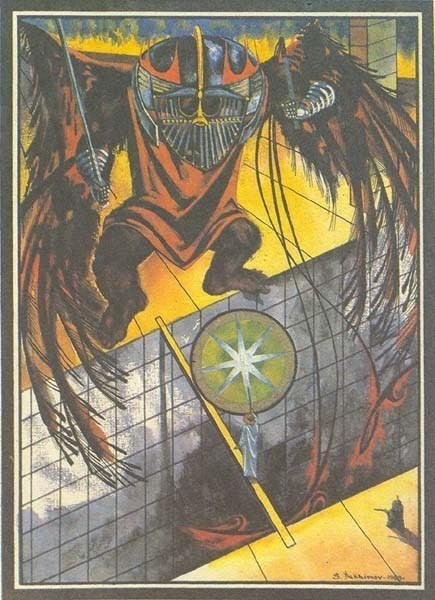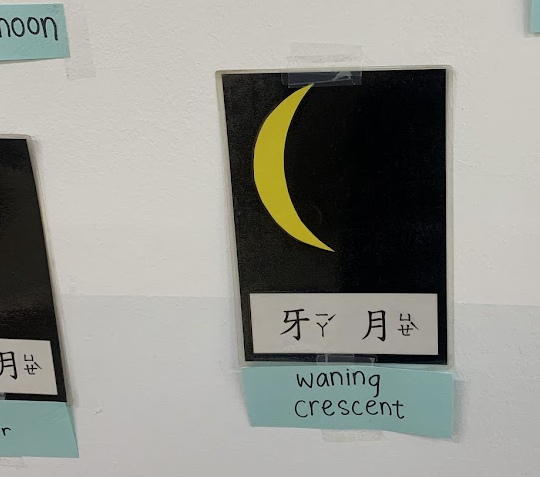Once in a while you get shown the light in the strangest of places if you look at it right.
Tuesday, October 29, 2024
Malachi, and the Small Plates as Nephite pseudepigrapha
Friday, October 25, 2024
No, Babylon Bee, YOU forgot.
Monday, October 21, 2024
DF and recycling
But his heart is in the right place
Dawkins believes that the placement of every nerve and artery (and other elements of bodily structure) is precisely sculpted by evolution. Yet he does not discuss the condition known as situs inversus, which can cause the heart to be on the right rather than the left, without causing medical symptoms or complications.
A wise man’s heart is at his right hand; but a fool’s heart at his left (Ecclesiastes 10:2).
Sunday, October 20, 2024
See-more Glasses and passing as Jewish
I was in my study reading a commentary on the Book of Job when the name Seymour Glass (a J. D. Salinger character) suddenly popped into my head, seemingly out of nowhere. Try as I might, I couldn’t trace its origin in my train of thought. I got to thinking about the name and connected it with Gotthard Glas, the birth name of Uziel Gal, inventor of the Uzi submachine gun, which made me wonder if Seymour Glass was Jewish. (Yes, I could remember the birth name of an Israeli firearm designer but not the ethnicity of a major literary character. Such are the vicissitudes of memory!) Looking that up led me to an article called “How Jewish was J. D. Salinger?” It begins thus:
In 2018, I wrote a book about the Jewish-American writers — Saul Bellow, Bernard Malamud, Philip Roth, and the others who powered the golden age of Jewish writers in post-war America. I thought of including Jerome David Salinger, known to the world as J.D. Salinger, but I quickly realized his Jewishness was a complicated saga.
Was Salinger Jewish? There is no simple answer. His Jewish roots certainly ran deep on his father’s side. His paternal grandfather was a Lithuanian immigrant who served as a rabbi in Louisville, Kentucky, before becoming a doctor. His father, Sol, belonged to Temple Emanu-El, the prominent reform synagogue in New York, where he worshipped on the high holidays of Rosh Hashanah and Yom Kippur.
But Salinger’s mother came from entirely different stock. Born in Iowa to the Jillich family, who were Catholics of Scotch/Irish descent, she was christened Marie. When she married Sol, she changed her first name to the more Jewish-sounding Miriam (Moses’ sister). As Miriam Salinger, she “passed” as Jewish — no small irony in 1920s America. Jerry Salinger didn’t find out his mother wasn’t the Jew she pretended to be until just past his bar mitzvah.
A recent post about black falcons unexpectedly digressed into the story of the Philip Roth character Coleman Silk, a mulatto who decides to hide his Black background and pass as Jewish. So running into Roth’s name and then a reference to a gentile passing as a Jew was a bit of a sync.
The Emanu-El reference was a sync, too. In a comment on my recent post “A Proverb,” Kevin makes a pun on “I can’t” and I. Kant, the philosopher. This led me to look into that name, and I discovered that Kant had actually been baptized Emanuel, changing the spelling to Immanuel only after learning Hebrew. This gentile changing his name to make it more Jewish syncs with the case of Marie/Miriam Salinger. (Although apparently Emanuel is a perfectly Jewish spelling as well, if it’s the name of a synagogue!)
In the end, I did find out how Seymour Glass got into my head. I must have glanced at this bag my wife put in the study:
It’s from a shop called Seemore which sells eyeglasses — so a pretty clear link to Seymour Glass. The name on the bag must have influenced my train of thought without it consciously registering.
Of course, the significance of “see-more glasses” will not be lost on my Mormon readers.
An unusually chaotic dream sequence
Little Miss
A Proverb
Fuzzy Wuzzy
Saturday, October 19, 2024
Quoth that Black Bird, "Not Again!"
Wednesday, October 16, 2024
Jesse Eisenberg: the connecting link between Chipmunks and Bigfoot
I mentioned the Chipmunk Christmas special above, which I thought of earlier in relation to Raphael and the fourth Turtle-Chipmunk. Although there are three chipmunks like usual, the group actually gains a fourth 'chipmunk' at the end of the movie, when Tommy (who I already identified with Joseph) joins them on stage at Carnegie Hall and plays his Golden Echo Harmonica alongside Alvin. For some reason this seemed to further support the idea of Joseph as Raphael in my mind. In addition, Tommy was a human boy, whereas the Chipmunks are, in fact, rodents. This might also speak to the idea or concept that Joseph, as this fourth non-Chipmunk, was and is in another form or state of Being than the other three Chip Monks who had to take on hairy animal bodies as part of their role in the plan.
Tuesday, October 15, 2024
Meme syncs: Good Times Roll, Reality Temple, Blue Wizards
In his September 2023 post "Asenath vs. the Son of Baal-ox within the Sawtooth Mountains" (on the old, public blog), William Wright tells a story, which he believes took place in 2020, about Asenath defeating a Balrog in the Sawtooth Mountains and successfully bringing out what he was then calling the Sawtooth Stone. After this, he mentions the Cars song "Good Times Roll" and connects it with this stone:
The day after the successful mission of Asenath and her return home (April 22) a few Good Beings seemed really happy with the state of affairs. After communicating a few thoughts, they referenced a well known song by The Cars "Good Times Roll", by saying basically just that: "Good times to roll!"
The reference actually gained a bit more meaning and humor to me only earlier this year. I had actually not connected the Sawtooth Stone with the stone cut from the mountain without hands (referenced in one of my earlier posts) until just a few months ago, for whatever reason. D&C 65:2 is where we get the very Mormon reference of that stone rolling forth to the ends of the Earth:
The keys of the kingdom of God are committed unto man on the earth, and from thence shall the gospel roll forth unto the ends of the earth, as the stone which is cut out of the mountain without hands shall roll forth, until it has filled the whole earth.
I now believe that the Beings who said that were having fun in tying the title and lyrics of that song to the Stone. A path had now been cleared for the Stone, which will create some Good Times, to do some rolling.
Later, in August 2024, Bill would decide that the Sawtooth Stone is red in color and begin referring to it as the Rose Stone instead.
This morning (Tuesday morning here, still Monday in many countries), I checked a couple of blogs and found a meme post illustrated with this image:
There's that same line, "Let the Good Times Roll," and the picture is a skeleton holding what looks like a glowing red ball or stone -- a pretty clear link to Bill's own use of that song title.
The skeleton looks a bit demonic, and I wondered if it could be a synchronistic nod to the Balrog featured in Bill's story, and if pre-Peter Jackson artists had ever portrayed the Balrog with skeleton-like features. I ran a couple of searches for vintage illustrations of the Balrog scene. Nothing skeletal turned up, but I did find this very strange 1993 illustration by the Russian artist Sergei Lukhimov:
There's a lot that's strange about this picture -- for example, the fact that the Balrog looks like a cross between a flying monkey from The Wizard of Oz and Dark Helmet from Spaceballs -- but the main thing that caught my eye was the eight-rayed "star anise" nimbus emanating from Gandalf's wand.
Included in the meme post was this meta reference to that weird Reality Temple meme:
There was also this, which reminded me of "Two cunning wise ones, 'Wizards,' Blue gowned":
Monday, October 14, 2024
WanderingGondola is posting
Sunday, October 13, 2024
Signal Graces: The Rosary as a sync magnet
Those who faithfully serve me by the recitation of the Rosary shall receive signal graces.
A “signal grace” is a free gift from God (grace) that is extraordinary in nature and evident in some manner (signal). It may be a visible sign or deep interior feeling that a prayer has been answered or a direction you’ve been seeking has been given. Another name for signal grace is “God-incidence,” a play on “coincidence” as with God there are none, because God actually works in that mysterious intersection where seemingly unrelated events in space and time meet up.
What are signal graces? I bet you've had signal graces before and just called them coincidences. What if that coincidence was God trying to encourage you or communicate with you? What if you could count on God communicating with you in this way? It turns out you can!
Earlier this month, after more than a year of praying the Rosary every day, I decided to stop for a while just to see what would happen and to prove to myself that it hadn't become a superstitious compulsion. The main effect I noticed was that syncs stopped as if turned off with a tap. (I wish I'd known that trick back when I was trying to make new syncs stop for a while!)
Comfort mask subverts imagination
Saturday, October 12, 2024
On this rock
William Wright posted about some dreams he had in "Going swimming and Silver Stein Books." I mentioned in a comment that Silverstein was a common Jewish name, and then Bill thought of Shel Silverstein, who is probably best known as a children's author but who also did various other things, such as drawing cartoons for Playboy and writing some well-known songs performed by other artists (most notably "A Boy Named Sue" and "The Cover of the Rolling Stone"). I never read any of Silverstein's books as a child, my parents having correctly identified him as someone to whom children should give a wide berth, so I know him mainly for the two songs mentioned. "The Cover of the Rolling Stone" is very well-written, and of course the title -- a "rolling stone" which is also something you can read -- fits right in with Bill's ideas.
Bill's dream was specifically about Silver Stein books, though, so I searched for some of his children's poems. One of the ones I found caught my eye:
The narrator of the poem loses his head and can’t find it because he no longer has eyes with which to look or a brain with which to think. In the he decides to "sit down / On this rock / And rest for just a minute" -- the joke being that the "rock" is actually the missing head.
This made me think of Peter for two reasons. First, back in August I posted "Where is Peter's mind?" connecting Peter with that Pixies song and the idea of a missing mind or head. Second, the Silverstein poem devotes a whole line to the words “On this rock,” which is a familiar turn of phrase:
And I say also unto thee, That thou art Peter, and upon this rock I will build my church; and the gates of hell shall not prevail against it (Matt. 16:18).
Only after making those connections did I check Bill’s latest post and discover that he, for entirely different reasons, has also connected Silverstein with Peter. The title of the post is “Shel Silverstein, Michael’s Book, and Peter.”
I remembered that I had once used Silverstein on this blog as a general reference to Jews, but at first I couldn’t find where. It turns out it was actually the closely related name Silberstein, and it was in the March 2023 post “An odd stereotype from H. G. Wells: Orientals live fast, die young.” The post also has to do with quicksilver, or mercury.
Friday, October 11, 2024
An adopted baby and two whales
Once there was a father, mother, and a baby. But a few seconds later, the world was ending, so for the baby’s safety they put him in a volcano. The volcano exploded, sending the baby to Earth 2, where whales took him in. He got older and became Super Kid.
Thursday, October 10, 2024
Wednesday, October 9, 2024
Further thoughts on the discipline of the Rosary
For behold, if a man being evil giveth a gift, he doeth it grudgingly; wherefore it is counted unto him the same as if he had retained the gift; wherefore he is counted evil before God.And likewise also is it counted evil unto a man, if he shall pray and not with real intent of heart; yea, and it profiteth him nothing, for God receiveth none such (Moro. 7:8-9).
[T]he popular forms of doctrine . . . alone can vary and alone destroy one another; the Kabalist is not only undisturbed by trivialities of this kind, but can provide on the spot a reason for the most astonishing formulae. It follows that his prayer can be joined to that of humanity at large, to direct it by illustrations from science and reason and draw it into orthodox channels. . . .
Could anything alienate the true initiate from public prayers and temples, could anything raise his disgust or indignation against religious forms of all kinds, it would be the manifest unbelief of priests or people, want of dignity in the ceremonies of the cultus -- in a word, the profanation of holy things.
What I got from this -- the message I personally was to get from it, not necessarily applicable to others -- was that it is important to maintain some kind of connection with the prayers and worship "of humanity at large." To follow one's own intuitions and understanding, yes, but not to become entirely a quirky sect-of-one. Even as I pursue my own freewheeling "Romantic Christian" path, I place considerable importance on regular engagement with the Bible and the Rosary, and even occasional participation in public worship of various sorts.
Overall, though, I do like the experiment. I have found myself throughout the day chanting random pieces of the Rosary, even parts I don’t really understand or have fully memorized. Just little bits and pieces that come back to me even though I’m not trying to think of them. For some reason they come to mind and mouth at random times, which probably isn’t a bad thing.
With time, the silence or concentration without effort becomes a fundamental element always present in the life of the soul. It is like the perpetual service at the church of Sacre-Coeur de Montmartre which takes place, whilst in Paris one works, one trades, one amuses oneself, one sleeps, one dies.
Why didn't Jefferson do the Old Testament?
Quick sync notes: pentagram geometry and toothy worms
In which I am unexpectedly given a blank red book
Tuesday, October 8, 2024
The polygamy escape clause
Monday, October 7, 2024
More Dr. Seuss Bowdlerization
The Book of Tooth
In my September 26 post "You'll find them in a lion's mouth," I mentioned that I had been reading The Tooth Book again and again to a child who kept requesting it. The post title is a line from the book, in which them refers to teeth, but I reinterpreted it as referring to books, and specifically to sacred texts.
My next post after that, "The eyeing d'Epstein -- plus Bonifacio Bembo and Optimus Prime," included this short video from the Morgan Library and Museum about the Visconti-Sforza Tarot cards:
My reason for watching the video was to see the 14th-century French casket in which the cards are stored. However, the talking head in the video mentions that Antoine Court de Gébelin "traced the imagery on the Tarot deck back to, of all places, ancient Egypt, specifically to the Book of Thoth."
I don't know how you pronounce Thoth, but the most common pronunciation I've heard rhymes with both, with the initial th pronounced the same as the final one. (One exception would be former Internet atheist Martin Willett, who in his SmiteCam project -- calling down the wrath of various gods in the hope of being smitten live on video -- shook his fist at the sky and shouted, "Thoth! Thquath me like a moth!") Those with more Continental influence may pronounce it as tote or taught, with hard t sounds. What I've never heard, except in this video from the Morgan, is the pronunciation "tawth," with a hard t and the beginning and a fricative th at the end. This anomalous pronunciation obviously brings it very close to the English word tooth.
So I began thinking of The Tooth Book and the Book of Thoth together.
This connection was reinforced when, on September 30, I was at the same school where I'd been reading The Tooth Book and saw that they'd put the phases of the moon up on the wall. This one caught my eye:
The Chinese, which is the same for both the waxing and the waning crescent, is 牙月 -- literally "tooth moon." Thoth is of course a moon god, and is specifically associated with the crescent moon. Most Egyptologists believe that the reason Thoth is depicted with the head of an ibis is that the ibis's beak resembles a crescent moon.
I've also been finding some syncs connecting The Tooth Book with The Nephilim Looked Like Clowns. The very first page of The Tooth Book asks, "Who has teeth?" and answers that "red-headed uncles do." In the rest of the book, the majority of the people in the illustrations are redheads. Throughout The Nephilim Looked Like Clowns, Paul Stobbs emphasizes how bright red hair is associated with the Nephilim. At one point, he discusses the discovery in the Great Serpent Mound of
a six-foot skeleton with two rows of teeth (a genetic marker standard in Nephilim), but it was missing its wisdom teeth. The archaeologists and biologists who examined the strange skull concluded this was an adolescent who had not yet lost their first set of baby teeth.
The Tooth Book talks about how you will grow "two sets [of teeth]: set one, set two." (This gives each person a lifetime total of 52 teeth, the same as the number of ivories on a piano. The skeleton lacked wisdom teeth, though, so it would have had only 48.)
The other day one of the bookcases at my school caught my eye. Lettering on the side of the case, put there by one of my employees of her own initiative some seven years ago, reads, "Grab a bite to read!" This can't really be considered a sync, since it's been there all along, but still, referring to a book as "a bite" fits right in with the Book of Tooth theme.
Another idea that came to mind is that a "tooth book" might be a book that requires "teeth" to eat, that is, a "hard" book. This could be related to the well-known "milk vs. meat" metaphor from the Epistle to the Hebrews.
Saturday, October 5, 2024
Hairy anatomical holes
When one imagines larger-than-life humanoid sightings in the modern era, the most mainstream example is the hairy apple of every cryptozoologist's keen eye: Bigfoot.
Be careful around the fabric of reality, Garfeld
I randomly ran into this this morning. It fits in with the old warp-and-woof black hole theme:
When I tried to find the original Garfield strip this is based on, my first searches just turned up countless variants on this "fabric of reality" meme, so I guess it's fairly popular, although I'd never seen it before.
I did eventually track down the original strip: March 2, 1979:
Friday, October 4, 2024
Based polygamy denier
Thursday, October 3, 2024
Star anise
Wednesday, October 2, 2024
Ellen and the thousand ships
James, Santiago, Eru, and Charles Wallace
The red ripeness of round leaves is thickWith the spices of red summer.
Tuesday, October 1, 2024
Like clowns
Merry Christmas
Unless the sync fairies have other plans, this will likely be my last post until after Epiphany. I wish all my readers a merry Christmas. He...

-
Following up on the idea that the pecked are no longer alone in their bodies , reader Ben Pratt has brought to my attention these remarks by...
-
Disclaimer: My terms are borrowed (by way of Terry Boardman and Bruce Charlton) from Rudolf Steiner, but I cannot claim to be using them in ...
-
I dreamt that a very large man walked into the lobby of my school. He was maybe six foot six and looked like he weighed well over 400 pounds...




































